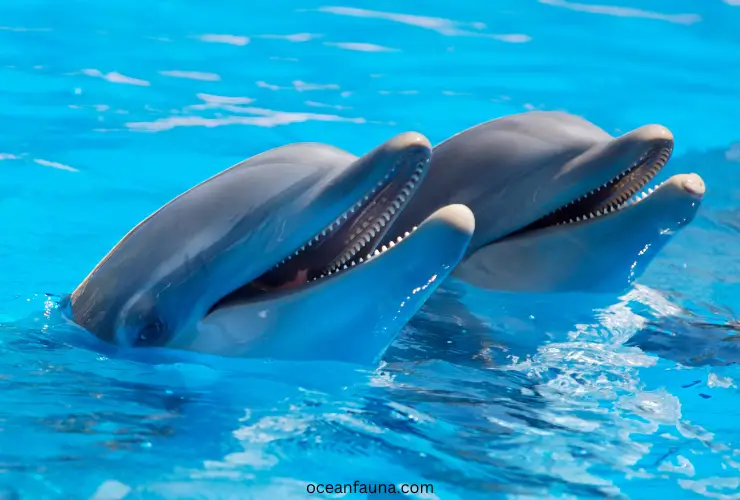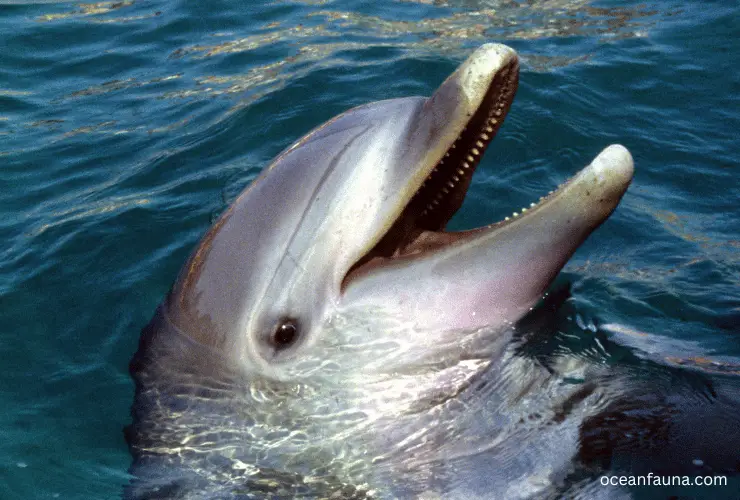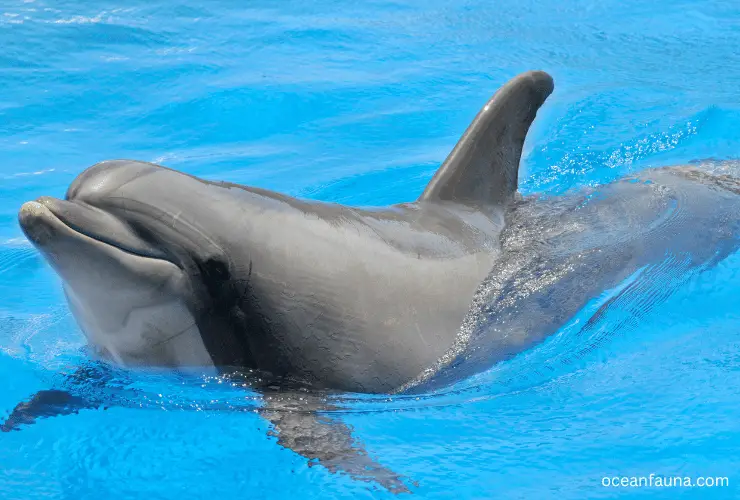Many people wrongly assume that all sea creatures are fish. However, this is inaccurate as some belong to different classes. For example, whales, dolphins, and porpoises belong to the cetacean family, which is a group of marine mammals. So, dolphins are mammals and not fish.
However, so many scientific and biological reasons exist why dolphins are mammals instead of fish. In this article, we will look into them. So, let’s dive into Detail.
Is a Dolphin a Fish or a Mammal?
Dolphins are not fish, they are actually mammals. Although they live in the water, dolphins have many similarities to other mammals. They breathe air through their lungs, so they have to come to the surface of the water to get air, which is different from fish that use gills to get oxygen.
Moreover, dolphins nurse their young with milk, a defining trait of mammals.
Additionally, the anatomy of dolphins includes hair follicles, which are present in all mammals and entirely absent in fish. These characteristics clearly indicate that dolphins are, beyond any doubt, classified as mammals.
What Type of Animal Is a Dolphin?
Dolphins are aquatic mammals that are often referred to as some of the most intelligent creatures on the planet. These animals are highly social, have playful behavior, excellent communication skills, and can swim quickly.

Physical Characteristics of Dolphin
Dolphins belong to the family Delphinidae, a group of marine mammals that includes over 40 species. These species vary in size and appearance but share some common physical characteristics.
Dolphins have streamlined bodies that are perfect for swimming through the water and sleek skin that allows them to glide through the water with minimal resistance. They are also known for their unique dolphin snouts, which are used for breathing and for echolocation.
Habitat and Behavior of Dolphin
Dolphins are found in oceans and rivers worldwide, with the highest dolphin concentration in warm, tropical waters. They are highly social creatures and are often seen swimming in large groups or pods.
Dolphins are known for their playful behavior, and they often engage in acrobatic displays, such as jumping out of the water or spinning in the air. They are also known for their excellent communication skills, using a series of clicks and whistles to communicate with other dolphins in their pod.
Diet and Predators
Dolphins are carnivorous and primarily feed on fish and squid. They are also known to sometimes hunt for small crustaceans, such as shrimp or crabs. While dolphins have few natural predators in the wild, they are still at risk of being hunted by killer whales or sharks.
Dolphins can sometimes become entangled in fishing nets or other debris, leading to injury or death.
Why Dolphins Are Mammals, Not Fish? [Detail Explanation]
Millions of years ago, whales’ and dolphins’ ancestors were small, dog-like mammals that lived on land. Here are the reasons why dolphins are mammals instead of fish.
Dolphins Give Birth to Live Young
One of the main reasons why dolphins are mammals and not fish is that they give birth to live young. Fish lay eggs, but mammals give birth to live young. Dolphins are no exception.

Female dolphins have a gestation period before giving birth to a single calf. The calf is born tail first, and the mother assists the calf to the water’s surface for its first breath.
Warm-Blooded
Dolphins are warm-blooded animals, which is another characteristic of mammals. Fish are cold-blooded, so their body temperatures depend on the surrounding environment.
On the other hand, dolphins can regulate their body temperature internally, allowing them to adapt to different temperatures in their environment.
Mammary Glands
Mammals have mammary glands that produce milk to feed their young. Dolphins also produce milk to feed their young, which is another indicator that they are mammals.
Hair
Another feature that distinguishes dolphins from fish is the presence of hair. While dolphins do not have hair all over their body, the newborn calves have a few bristly hairs on their beak, which disappear within a few weeks.
Breathing Air
Fish breathe underwater through their gills, while dolphins breathe air through their lungs. Dolphins must come up to the surface to breathe every few minutes. They use the blowhole on the top of their head to take in air.
Do Dolphins Have Lungs?
Yes, dolphins do have lungs. In fact, like humans and other mammals, dolphins breathe air using their lungs. However, unlike humans, who can hold their breath for a short period of time, dolphins cannot stay underwater for very long and need to come up to the surface regularly to catch a breath.
Dolphins have a pair of lungs that are perfectly adapted to their aquatic lifestyle. These lungs are similar to those of land mammals, but they are more elongated and can exchange more oxygen with each breath.
Additionally, dolphins have a large amount of blood in their bodies, allowing them to store more oxygen for longer periods.
To breathe, dolphins use a blowhole located on the top of their heads. This blowhole is connected to their lungs and allows them to quickly inhale and exhale air without opening their mouths. By using their blowhole, dolphins can breathe without interrupting their swimming or hunting activities.
Do Dolphins Drink Milk from Their Mother?
Yes, dolphins do drink milk from their mother’s mammary glands. These glands are located on the underside of the dolphin’s body near the genital slit. To drink milk efficiently, the calf wraps its tongue in a straw-like position to lock out seawater and maximize milk intake. The female dolphin has two mammary slits, each with a teat beneath it.

The calf places its beak into the slit while slightly opening its mouth to form a cone with its tongue. This cone-shaped tongue latches onto the seat to securely hold it in place while nursing. Interestingly, the milk ejection or let-down process is under the voluntary control of the mother.
Dolphin milk, like human milk, is rich in fats, proteins, and other essential nutrients required for the growth and development of the calf. The milk contains approximately 12% fat, making it one of the richest mammalian milk. The milk is also high in lactose, which is important for the calf’s energy needs.
Dolphins have a unique nursing behavior where the calf swims upside down, with its tail up and head down, while nursing. This unique feeding position allows the calf to latch onto the teat with ease and maximize milk intake. The mother also helps the calf by supporting it with her flippers while nursing.
Are There Any Similarities Between Dolphins and Fish?
Yes, there are several similarities between dolphins and fish, as they both have adapted to live their entire lives in aquatic environments.
One similarity is the streamlined shape of their bodies, which allows them to move efficiently through the water. The tapered, pointed shape of their bodies minimizes friction and turbulence and helps them avoid predators and prey.
Another similarity is their use of fins to move through the water. Both dolphins and fish have fins to propel themselves forward, steer and maneuver, and maintain stability in the water.
Dolphins’ large, powerful tail flukes are used for propulsion, while their dorsal and pectoral fins are used for steering and stability. In fish, their dorsal, pelvic, and anal fins are used for propulsion, steering, and stability.
Dolphins and fish also share adaptations that enable them to breathe underwater. Both have gills that absorb oxygen from the water and have developed efficient respiratory systems that allow them to take in and expel large volumes of water efficiently.
Also, dolphins have evolved a unique method of breathing that enables them to hold their breath for extended periods of time. By storing oxygen in their muscles and slowing their heart rate, dolphins can dive to depths of up to 1000 feet and stay submerged for as long as 20 minutes.
What Are the Dissimilarities Between Dolphins And Land Mammals?
You know why dolphins are mammals. Do you know there are some dissimilarities between marine and land-dwelling mammals?
Dolphins and land mammals are vastly different from each other despite being classified as mammals. Let’s take a closer look at their dissimilarities.
Habitat:
The most obvious difference between dolphins (marine mammals) and land mammals is their habitat. While land mammals live on land, dolphins thrive in water. Dolphins are highly adapted to their aquatic environment and cannot survive on land like land mammals.
Movement:
Land mammals move on land by walking or running on their legs, while dolphins swim in water using their powerful fins. Dolphins can swim at high speeds and even leap out of the water, something that land mammals cannot do.
Skin:
The skin of land mammals is covered by fur or hair, while the skin of dolphins is smooth and sleek. This helps them to swim faster and more efficiently in water.
Breathing:
Another difference between dolphins and land mammals is how they breathe. Unlike land mammals, who breathe through their nose, dolphins use a blowhole located on the top of their head to take in air when they surface above the water. This unique feature allows dolphins to stay submerged for longer periods, despite both species having lungs.
Reproduction:
Dolphins and land mammals have entirely different mating and reproduction systems. Land mammals mate on land by copulating, while dolphins mate in water. Dolphins also have a longer gestation period and give birth to only one calf at a time, whereas land mammals usually give birth to multiple offspring.
Is There Any Fish Called “Dolphin”?
Yes, there is a fish called a dolphin, but it is not related to the marine mammal of the same name, a Delphinidae family member. Instead, the dolphin fish belongs to the family Coryphaenidae, and there are two species of dolphin fish: the common dolphin fish (Coryphaena hippurus) and the pompano dolphin fish (Coryphaena equiselis).

Common dolphin fish
The common dolphin fish, mahi-mahi or dorado, is a popular game fish in tropical and subtropical waters worldwide. It has a distinctively long dorsal fin and vibrant coloration, with green and blue on the upper body and yellow on the sides. It is highly sought after by recreational anglers for its speed, acrobatic leaps, and delicious white flesh.
Pompano dolphin fish
The pompano dolphin fish is a lesser-known species found in the Atlantic Ocean from New Jersey to Brazil. It resembles the common dolphin fish but has a shorter head and broader dorsal fin. It is generally smaller than the common dolphin fish and less frequently targeted by anglers.
Conclusion
Hopefully, now you are clear that although there are some similarities between dolphins and fish, they are actually marine mammals. If you still have any queries, you ask me. I will answer them asap.

